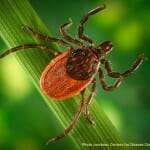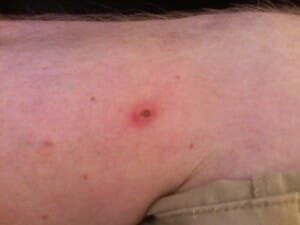 The beauty of many of our Alberta golf courses is the tree lined fairways. I can attest to the fact that I have had up close and personal encounters with some of these trees while tromping through the underbrush in an attempt to find my ball. Having read an article written by Michelle Gagnon in the Rocky Mountain Outlook about Ticks and the risk of the Lyme disease I am more inclined to take the penalty strokes and leave the ball where it lies.
The beauty of many of our Alberta golf courses is the tree lined fairways. I can attest to the fact that I have had up close and personal encounters with some of these trees while tromping through the underbrush in an attempt to find my ball. Having read an article written by Michelle Gagnon in the Rocky Mountain Outlook about Ticks and the risk of the Lyme disease I am more inclined to take the penalty strokes and leave the ball where it lies.
Lyme disease is caused by a bacterium called Borrelia burgdorferi. The bacterium is spread from small animals to humans by little biting arachnids called ticks. Ticks are like vampires – they attach to you and suck away, quite possibly and inadvertently leaving behind the bacterium called Borrelia burgdorferi. The name of the bacterium is not as important as the damage it can do if a person is unfortunate enough to be exposed to it.
One of the first signs of Lyme disease is a bulls-eye rash around the site of the tick bite. Not all people get this rash so early detection may be missed. Other symptoms in the early stages are: fatigue; chills; headaches; joint and muscle pain and/or swollen lymph nodes. If you experience these flu- like symptoms after you have been in or near tree and shrub bed areas it may be prudent to visit your family doctor.

If untreated the consequences may become more severe – possibly involving the central and peripheral nervous systems; the joints; and the heart. Afflicted individuals often experience extreme fatigue and general weakness.
Specialized tests are necessary to confirm the diagnosis of Lyme disease. Treatment depends on the symptoms and where in the body the bacterium has settled.
As with many medical conditions awareness and prevention is the best approach. After you, your family members and your pets have been romping in the woods do a self check to insure that one of these little critters has not attached itself to your skin. If a tick has decided to tag along for the ride home remove it with caution. Using tweezers grasp the tick’s head and mouth parts as close to the skin as possible and pull gently. Do not traumatize the tick by squeezing or twisting it – this can cause the tick to regurgitate its stomach contents into your blood. Yuck! As much as you may wish to destroy it – resist the urge. Place it in a zip lock bag as it may provide important information if you develop symptoms.
For more information, go to the Public Health Agency of Canada website http://www.phac-aspc.gc.ca/id-mi/lyme-fs-eng.php.
